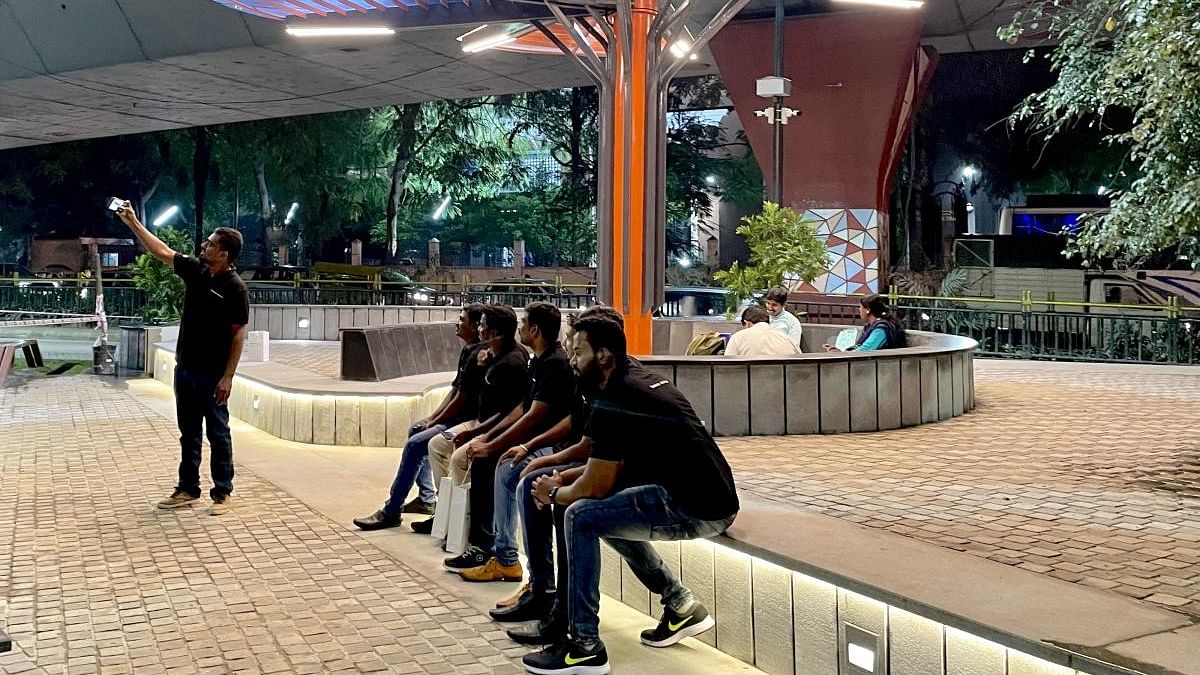

As the clock strikes 10, people are shooed out of Bengaluru’s parks by security guards.
Most parks in the city close by 10 am, opening again only between 4 and 8.30 pm.
“Who are these places built for?” wonders Srinivas M, a 62-year-old Malleswaram resident.
The lack of public spaces, as also the increasing cost of spending time outdoors, is a constant conversation on social media.
Some in the Bruhat Bengaluru Mahanagara Palike (BBMP) say they are aware of the problem.
Modern-day ‘katte’
Thanks to the realisation, a neglected and rundown place in the heart of the city is now an open public space.
The BBMP has collaborated with city organisation Sensing Local and architecture firm The Hull to create a ‘katte’ at Maurya Circle, near Freedom Park.
“While we were whitetopping the roads, we noticed this patch. It was used for dumping garbage. We decided to turn this around, and make it a public space,” says M Lokesh , BBMP chief engineer (projects). Spread across 13,000 sq ft, the space includes an amphitheatre, a gazebo and a working area, complete with LED lights and charging ports. Renovating and redesigning the area cost the civic body Rs 1.25 crore.
A modern take on the traditional ‘katte’ (platform where people gather to chat) is an amalgamation of local architecture and modern-day needs.
“The area has quite a few ancient trees, and we wanted to build a public space around them. We looked into design sensibilities prevalent in our vernacular architecture, and translated it to a modern context,” says Rahul Srikrishna, principal architect, The Hull.
The open space was created after five months of research. “We wanted to build a space catering to all user groups,” he explains.
More coming up
The BBMP plans to develop more such public spaces across the city. “We are planning something similar for the space under the Anand Rao Circle flyover. Such spaces also help beautify the city,” says Lokesh.
It is important a public space is created keeping in mind the needs of the locatity, says Rahul. “The same model cannot be replicated in every locality. A public space needs to be site specific. Every location has an economic context and sub context, these public spaces need to react to that,” he adds.
Such ‘kattes’ are a good way to incorporate public spaces in every locality, believes Yashaswini Sharma, architect, author and resident of Malleswaram. “There doesn’t necessarily need to be just one big public space in a locality. Instead, there can be several smaller public spaces. They bring out a sense of community, which is currently lacking,” she says.
Problem of gating
The constant gating of public spaces is at the root of this problem, believes Yashaswini. “In theory, Bengaluru has public spaces, but they are guarded from the public. I remember, back when I was in school and college, my sister and I would walk around Vidhana Soudha, and read books on the lawns there. Today, the place is all gated. Take Lalbagh for instance, the lawns are guarded from the public,” she points out.
While some public spaces are open in older localities like Malleswaram and Jayanagar, the newer layouts lack anything like this. “Even public property is fenced and guarded. Spending time out leisurely in public makes you feel like you’re doing something wrong, when in fact you’re not,” says Prashanth Nandiprasad, proprietor, Etagi Design Collaborative. He believes the city needs more inclusive infrastructure.
Even something as simple as installing good quality benches in common areas can help. “Somewhere to quickly rest or meet your friends. You don’t need elaborate and fancy design. Just simple spaces where people can relax without having to spend money,” he adds.
Hidden spaces
Architect and urban designer Naresh Narasimhan, believes there already exist several “hidden” public spaces that can be put to good use.
“These spaces are in plain sight. For example the Parade Ground and the army park near it… the public has no access to it. These areas can be closed for public use when the military needs them, but otherwise can be open to the public,” he says.
He suggests converting old factories and barren lands into common use public spaces. “There are about 100 acres behind the Byappanahalli metro station, which used to be an old factory of NGEF. Spaces like these can be utilised, but political will is lacking,” he adds.
He stresses the importance of creating pedestrian and public-friendly zones.
“We need to understand the difference between roads and streets. Vehicular movement is meant for roads and not streets. The Church Street model, which prioritises pedestrians, if implemented correctly, can be useful in many parts of the city,” he says.
Citizens’s POV
Tanuja Malla, 33, recently moved from Kolkata to Bengaluru. She has also lived in Mumbai.
“Compared to the two cities, Bengaluru is not really accessible to its citizens. Any place you go, you end up spending money. Plus, getting to these said public spaces is difficult as public transport is expensive,” says the Whitefield resident.
For 24-year-old Nivedha Sudhir, green patches are inaccessible. “While there is Cubbon Park, it comes with a long list of rules for the public. I wish I didn’t have to drive out of the city to enjoy a few minutes of greenery,” she says.